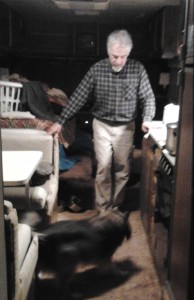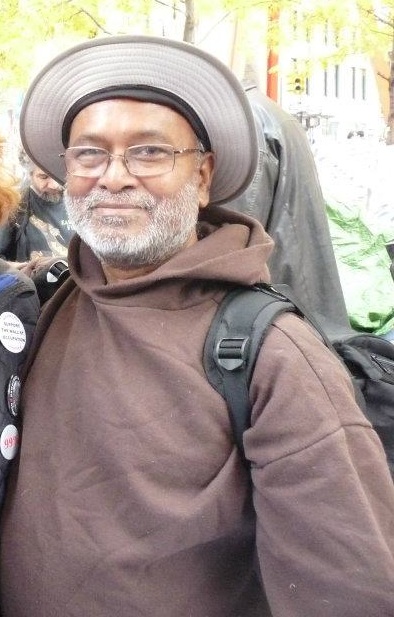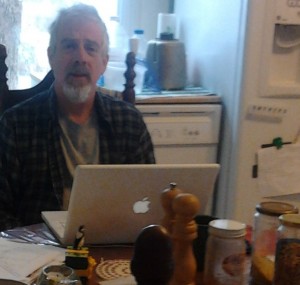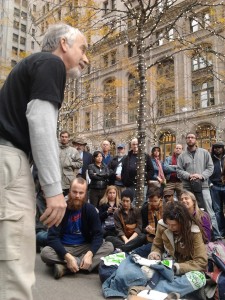Liberty at a Distance
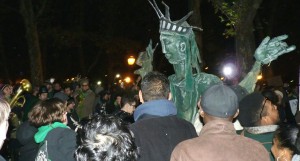 In all my travels to New York City I’ve only ever seen the Statue of Liberty from a great distance. And every time I’ve pulled into Philadelphia I’ve remarked that I have yet to see the Liberty Bell. I arrive in your town to organize, to breathe life into the American myth of Freedom.
In all my travels to New York City I’ve only ever seen the Statue of Liberty from a great distance. And every time I’ve pulled into Philadelphia I’ve remarked that I have yet to see the Liberty Bell. I arrive in your town to organize, to breathe life into the American myth of Freedom.
This doesn’t leave me a lot of free time.
As C.T. and I sat in a New York bistro, the air was uncharacteristically quiet as the sound system played Paul Simon singing American Tune. I felt some sort of vague gut punch at how applicable that song and its shellshocked mood is to the Occupy movement.
I don’t know a soul who’s not been battered
Don’t have a friend who feels at ease
Don’t know a dream that’s not been shattered
Or driven to its knees.
But it’s all right, all right, We’ve lived so well so long
Still, when I think of the road we’re traveling on,
I wonder what went wrong, I can’t help it
I wonder what went wrong.
I first heard this song, not from Paul Simon’s recording, but the bubble-gum group Starland Vocal Band. They were known for their harmonies, and they did a beautiful, defeated rendition I haven’t heard since the 1970’s. Hearing the song pops me back to those days, and thinking about Bill and Taffy Nivert, the songwriters at the core of SVB, who actually had some songwriting chops, collaborating with John Denver on “Country Roads” and others. But this is a passing thought as the lyrics play on. I move on to memories of hearing this song in busy moments, and stopping to appreciate how it captures the fall of empire. I’m heartbroken at the trap of American individualism, and the lie of the American Dream. Sometimes I’m struck at the coma the programmers must be in when they plan this song to play in malls. I imagine Paul Simon himself worked such thoughts out long ago, and is pensive all the way to the bank.
Here are the lyrics in full:
Many’s the time I’ve been mistaken, and many times confused
And I’ve often felt forsaken, and certainly misused.
But it’s all right, it’s all right, I’m just weary to my bones
Still, you don’t expect to be bright and Bon Vivant
So far away from home, so far away from home.
I don’t know a soul who’s not been battered
Don’t have a friend who feels at ease
Don’t know a dream that’s not been shattered
Or driven to its knees.
But it’s all right, all right, We’ve lived so well so long
Still, when I think of the road we’re traveling on,
I wonder what went wrong, I can’t help it
I wonder what went wrong.
And I dreamed I was dying. I dreamed my soul rose
unexpectedly, and looking back down on me, smiled
reassuringly, and I dreamed I was flying.
And far above, my eyes could clearly see
The Statue of Liberty, drifting away to sea
And I dreamed I was flying.
We come on a ship we call the Mayflower,
We come on a ship that sailed the moon
We come at the age’s most uncertain hour
And sing the American tune
But it’s all right, its all right
You can’t be forever blessed
Still, tomorrow’s gonna be another working day
And I’m trying to get some rest,
That’s all, I’m trying to get some rest.
Subscribe to this blog's RSS feed
Recycling Our Bed: Serenity Gets a Queen
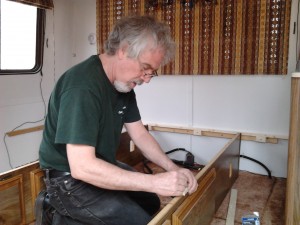 One major point of having Serenity, our rolling house/office, is to maintain that sense of home. We can cook our own healthy food, we have books, movies and music with us, Tuatha has his dog toys and knows that when we leave him in Serenity, we’re keeping him safe at home, where we’ll return.
One major point of having Serenity, our rolling house/office, is to maintain that sense of home. We can cook our own healthy food, we have books, movies and music with us, Tuatha has his dog toys and knows that when we leave him in Serenity, we’re keeping him safe at home, where we’ll return.
One nice comfort of home is sleeping in one’s own bed. We’re not on a hotel mattress, or a host’s sofa sleeper. We’re home. This is a point I care about, because I have arthritis and a bad back. I am particular about the surface I sleep on. I seem to do better with air mattresses or waterbeds generally, so in our motorhome, the choice was air.
But the devil always gets you in the details: The motorhome we ended up finding, that was it, and the perfect one, was imperfect in one detail: The back bedroom had two twin beds.
This will not do. Looking at the two beds with the built-in nightstand between, I constantly flashed back to The Dick VanDyke show, and poor Rob and Laura Petry who were not allowed to share a bed on prime time television. Weird how far we’ve come. And yet, the sex that gets shown is usually just a different way of oppressing people…
So C.T. and I designed and discussed. We consulted and conjured. It felt exciting to rip out the built-in frames of the twins, and to design the new queen bed platform using those pieces, planning for the little access doors to be functional. We expect to store two EZUp canopies under the bed, for impromptu workshops. We can keep extra tables and out of season clothes there. Living in an rv, we are learning how to maximize our space use.
Since we plan to travel the country with enough copies of C.T.’s books for the various Occupys, we have to account for the weight we add to the motorhome. We also have to plan how to distribute that weight. If we find ourselves in a jackknife situation on some highway, the weight distribution could be the difference between life and death.
It’s empowering to take responsibility for ourselves in this way. We have to learn the inner workings of all Serenity’s systems, and diagnose problems. We can change things and remodel. We can gut it, paint it purple, whatever.
No good DIY project is complete without a minor injury that bleeds profusely. This time it was C.T.’s turn, as he lost control of a screwdriver that stabbed him in the finger! Ouch!
In 1986, when Serenity rolled off the assembly line, few people had personal computers. and few would have thought of bringing such electronics with them on an rv trip. So it’s only the latest rv’s that have computer consoles. We need two or three, for our team.
So we plan to tear out a swivel chair in the living room and a vanity sink in the bedroom to create space for computer stations. And we’ll have to get mobile hot spots or some such things to have reliable internet. Right now, we’re mooching off our hosts, who allow us to park next to their house. They’ve provided a 100 foot internet cable and a plug in for 30 amp electrical service, which they had installed for our visit. We haven’t started using the water systems in Serenity yet. So we go into the house for showers, dishwashing, etc. But as the warm weather arrives, we’re considering starting up the water.
In the meantime, today will see a bulletin board mounted for project notes. The sun is dancing with the ocean breeze outside, where the dog is meditating in the grass. Life in Serenity goes on!
What the Cops Throw Away…Our First Visit to OWS Union Square
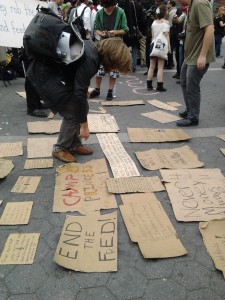
Pick up a sign to hold, or read an unfolding story. But hurry, the police/trash collectors are headed this way.
On Wednesday C.T. and I traveled into New York City for a meeting with the affinity group helping us organize a Spanish translated consensus workshop. There had been some thought to have the meeting at Union Square, the real estate Occupy Wall Street is newly claiming. And we had heard stories about occupiers’ first actions and sparring with police at Union Square. So even though we were meeting in the opulent comfort of the lattice and palm tree lined atrium at 60 Wall Street, C.T. and I left the subway early to check out the action at the new protest site.
The first picture I took was this one, of handmade cardboard signs laid out on the ground, like so many Occupys around the country. Sometimes it’s an art installation, sometimes the signs are spread out so you can pick one to hold out toward traffic.
No sooner did I snap my shot and pivot did I encounter a very grumpy gaggle of NYPD and park police, six or eight of them at least, who were pushing a large plastic trash bin on wheels toward the signs. They were followed by a wave of dozens of protesters, anyone who could track the bin, all taking pictures and calling out remarks about the pettiness of the police.
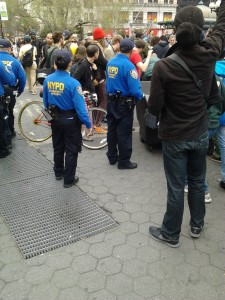
So many people were taking pictures of the cops picking up "litter," that this is as close as I could get for my own shot.
One officer started picking up the signs and tossing them in the bin, sometimes handing them to another officer. A protester circled the scene, urging other Occupiers not to get caught up in the provocative behavior of the NYPD.
It was a moment in time, after a night that saw several OWS activists arrested after midnight, and through 4 a.m. It was a moment in time before the 6 p.m. rally in honor of Trayvon Martin, the Florida teenager killed by a neighborhood watch captain.
Several members of our affinity group didn’t make our meeting at 60 Wall St. I imagine they felt a strong pull to attend the rally, which was also attended by Trayvon’s parents.
Later, on the train back to Long Island, a passenger told us the subways around Union Station had been closed by the police. This is a tactic they use before a “scrape,” or mass arrest. So C.T. and I worried for our friends. And when we got home, we did find an internet pic of one affinity group member being dragged by police in the early morning arrests (“That was 4 a.m.—He was out by the time of our meeting—Where was he?!?” C.T. joked), but there was no news about arrests associated with the rally.
 Another day on the Direct Democracy Tour.
Another day on the Direct Democracy Tour.
How long will OWS hold Union Square? Will they try to repeat the encampment? I don’t know these things, any more than I know how long C.T. and I can remain with the Occupy flagship. Our rv’s furnace is out, but spring is here. We don’t have much funding, but we have more eager students than ever.
There’s no mistaking the community and public spectacle that is a mass protest. That sense of being a part of the solution, a part of something larger 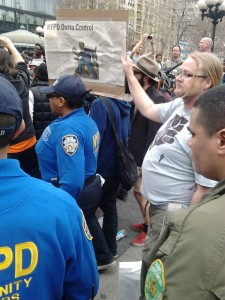 that yourself. There’s the speaking truth to power, or at least power’s security force, when a protester shames a cop for making up some law to enforce on the spot (“No suitcases…No libraries!” They warned me and C.T. last November). It’s electrifying. It’s something to do, when the only clothes you can afford were probably made by slaves, and the degree that cost you six figures earns you a convenience store existence.
that yourself. There’s the speaking truth to power, or at least power’s security force, when a protester shames a cop for making up some law to enforce on the spot (“No suitcases…No libraries!” They warned me and C.T. last November). It’s electrifying. It’s something to do, when the only clothes you can afford were probably made by slaves, and the degree that cost you six figures earns you a convenience store existence.
For some people, like this protester shadowing a Community Affairs officer with an article saying, “NYPD Outta Control,” things have gone so far that boldness and risk-taking replace comfort and free time. Other people seem to still be at home, plugged into the Matrix.
More people will come with the early spring. And C.T. and I are here in New York, saying to activists that consensus doesn’t have to be the shouting match/power play they experienced in Occupy’s infancy. We want these newly minted activists, this year’s and last year’s crops, to know that true consensus looks and feels very different from what they’ve experienced with the Madrid model.
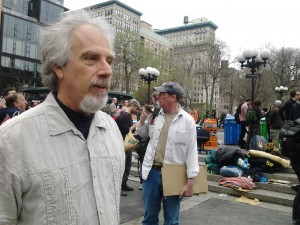 So as the nation and OWS rally over the killing of a Black teenager C.T. and I organize to hold a Spanish-translated Consensus: Body and Soul workshop. We pour over facebook invites and funding opportunities. We make calls and make lists. And when enough pieces are in place, we get on the train for the face to face organizing. It’s not as sexy as a rally, but it’s our form of witness.
So as the nation and OWS rally over the killing of a Black teenager C.T. and I organize to hold a Spanish-translated Consensus: Body and Soul workshop. We pour over facebook invites and funding opportunities. We make calls and make lists. And when enough pieces are in place, we get on the train for the face to face organizing. It’s not as sexy as a rally, but it’s our form of witness.
Maybe you have sidewalk chalk or a saxophone.
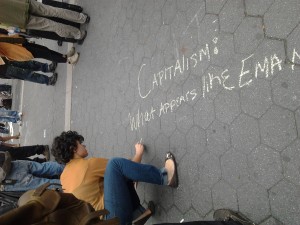 When you can’t stay away any longer, you’ll be like Richard, a man who wandered over to our Spanish workshop affinity group meeting at 60 Wall. He asked to sit in. We welcomed him and advised him to just observe, since he was not a member of our affinity group. After a half hour of listening to nine people speak the language of value-based consensus, with jargon like “level one discussion,” and “values embedded in the structure,” Richard couldn’t stand it anymore. “I hate to interrupt,” He said, not stopping himself from doing so. “But I don’t understand a thing you all are talking about. What is your group’s purpose???”
When you can’t stay away any longer, you’ll be like Richard, a man who wandered over to our Spanish workshop affinity group meeting at 60 Wall. He asked to sit in. We welcomed him and advised him to just observe, since he was not a member of our affinity group. After a half hour of listening to nine people speak the language of value-based consensus, with jargon like “level one discussion,” and “values embedded in the structure,” Richard couldn’t stand it anymore. “I hate to interrupt,” He said, not stopping himself from doing so. “But I don’t understand a thing you all are talking about. What is your group’s purpose???”
 In the meeting role of doorkeeper, I took him off to the side and explained that C.T. Butler is the cofounder of Food Not Bombs and author of several books on consensus and that the rest of the group are his students, learning how to conduct meetings not ruled by privilege and oppression. Richard told me he had never been an activist outside of his own mind before, and this day, the day that OWS had moved to Union Square, the day that the Trayvon Martin rally pulled half of our affinity group out of a nearly empty 60 Wall St., was his first time venturing into this world.
In the meeting role of doorkeeper, I took him off to the side and explained that C.T. Butler is the cofounder of Food Not Bombs and author of several books on consensus and that the rest of the group are his students, learning how to conduct meetings not ruled by privilege and oppression. Richard told me he had never been an activist outside of his own mind before, and this day, the day that OWS had moved to Union Square, the day that the Trayvon Martin rally pulled half of our affinity group out of a nearly empty 60 Wall St., was his first time venturing into this world.
It must have been boggling for him to have our group, with it’s new culture and strange language, be his first contact.
But don’t be boggled. When you can’t stay away any longer, bring your sidewalk chalk or your saxophone or a favorite children’s book you can replace when the police arrest it, and arrive in the river of people. Just make sure that one of your first appointments is a consensus workshop. Learn how, even with all the love in our hearts, we still bring privilege and oppression with us into situations of hope and repeat the same old patterns. Learn the language of breaking that pattern.
Then speak our new truth to power.
—WT
Please join our Hippie Chick Diaries fan page on Facebook!
Remembering Garda Ghista
C.T. received this today. —WT
Remembering Garda Ghista
by Stephen Lendman
Saturday Feb 25th, 2012
On February 20, activist/scholar/author/humanitarian, and dear friend, Garda succumbed to breast cancer.
On February 22, her son Firdaus reported the sad news. Receiving hospice care, she died in southern Germany. She’d been surviving by what she called “a series of miracles.” She’ll be sorely missed.
Several years ago she moved to India to help feed starving people. Using her own resources and what she could raise, she asked nothing in return.
Months back, she discussed her work on the Progressive Radio News Hour. She asked listeners to help best they could. She explained how little it takes to feed starving people without resources. Without aid, they’ll perish.
She advocated Prabhat Ranjan Sarkar’s philosophy. His spiritual name was Shril Shrii Anandamurti. He was an Indian author, poet, composer, linguist, social revolutionary and philosopher.
He founded Ananda Marga, a spiritual/social organization providing instruction in meditation, yoga, and other self-development practices to anyone wishing to learn them. Affectionately called Baba, he offered various social programs for disadvantaged and other Indians. His writings stressed human welfare and neohumanism.
His work inspired Garda’s socio-economic philosophy. She called it PROUT (PROgessive UTilization Theory). “It stands for the progressive utilization and rational distribution of all the earth’s natural resources. PROUT advocates another type of revolution called ‘nuclear revolution.’ ”
It reflects “every aspect of collective life – social, economic, political, cultural, psychic and spiritual.” It’s completely transformative. “New moral and spiritual values arise in society which provide the impetus for accelerated social progress.”
A new era replaces an old one. “(O)ne collective psychology is replaced by another. This type of revolution results in an all-round development and social program.”
Modern-day world systems destroy life, societies and ecologies. Sustainability’s not their mandate. They feature exploitation and plunder. Another way is vital.
Garda’s writings discussed constructive alternatives. Her World Prout Assembly (WPA) web site featured them. Her advocacy found expression in them. Her life’s work practiced them.
In January 2010, she founded Hearts Healing Hunger. It helps feed hungry people globally. It’s also involved in:
•building emergency shelters for women and girls victimized by domestic violence and human trafficking;
•protecting them from dowry harassment;
•building retirement and nursing homes for the needy;
•constructing libraries and literacy programs;
•establishing medical clinics;
•providing micro credit loans; and
•helping villages build sustainable water systems, check dams, embankments, drip irrigation, shallow wells, strategically located ponds, river and lakeside plantations, and planting thousands of trees.
Longer-term projects include creating ecologically and economically self-sustainable communities.
Most important is feeding the hungry. Initial Indian venues were established in Siliguri, North Bengal and Hyderabad, Andhra Pradesh. Other feeding centers were planned throughout the country. Achieving them depends on personal donations.
With Garda’s death, its site “currently (is) unable to receive money.” Hopefully it will again soon under others continuing what she began. Her work’s too important to disrupt.
It reflects PROUT’s mission “to unite moralists everywhere against exploitation anywhere.” It seeks “unsung heros” to confront oppression in all forms, including extremist fundamentalism, fascism, communism, patriarchy, and predatory capitalism.
They threaten all life forms, including planet earth and humanity. “Struggle starts (with) reclaim(ing) economic sovereignty of local communities.” PROUT sought to “unite all struggles against oppression into one global struggle (for) one world, one humanity, and one family.”
It challenged today’s order for what sustainably helps everyone everywhere. WPA headlined, “Economy of the People, For the People and By the People! Put Economic Power in the Hands of the People! Moralists of the world – unite!”
Garda lived what she believed. Her life’s mission was helping others by establishing life-sustaining initiatives. She gave all selflessly.
It doesn’t get any better than that. This writer was proud to be a friend and ally. Hopefully others will continue her vital work and enlist global support.
With out-of-control imperial wars raging and others planned, as well as deepening economic hardships for growing millions, it’s more than ever needed.
Spread the word, and keep Garda’s spirit alive.
———————————————————
Stephen Lendman lives in Chicago and can be reached at lendmanstephen [at] sbcglobal.net.
Also visit his blog site at sjlendman.blogspot.com and listen to cutting-edge discussions with distinguished guests on the Progressive Radio News Hour on the Progressive Radio Network Thursdays at 10AM US Central time and Saturdays and Sundays at noon. All programs are archived for easy listening.
http://www.progressiveradionetwork.com/the-progressive-news-hour/.
http://sjlendman.blogspot.com
Learning the Ropes/Walking the Plank/Twisting in the Wind/Cooking My Goose
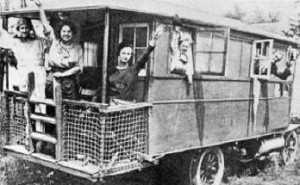 Think twenty-six is old for a motorhome? Well, you’re right. I just had a mechanic tell me he could bring his dad out of retirement to work on my carburetor. But it could be worse! I enjoyed perusing these photos of hilarious motorhomes from history.
Think twenty-six is old for a motorhome? Well, you’re right. I just had a mechanic tell me he could bring his dad out of retirement to work on my carburetor. But it could be worse! I enjoyed perusing these photos of hilarious motorhomes from history.
I seem to have this urge to choose the path that is most unusual, that forces me to stretch in ways those around me doubt I can. I don’t know what karma I’m working out when I dive in. My plans often seem random to others, and yet, I can imagine no other path in the moment.
So, here I am learning about boondocking and electrical systems and gas generators. I’m making mental notes about rubberizing roofs and the proper  handling of propane tanks. And through each day as we promote our workshop and phone truck mechanics, I can’t wait to get in there and tear out those twin beds, to lay down the found rug I bathed in the sun, to hook my car up to the tow bar.
handling of propane tanks. And through each day as we promote our workshop and phone truck mechanics, I can’t wait to get in there and tear out those twin beds, to lay down the found rug I bathed in the sun, to hook my car up to the tow bar.
So far, however, C.T. gets to play the butch one. He knows more about engines and electrical systems. So I play second fiddle, making confused looks and fetching tools.
Our dog Tuatha has taken to our motorhome Serenity like he’s been waiting for this moment he whole life. We were worried about him, losing the only home he’s ever  known. But Serenity is docked down in the valley, right on Heathcote’s central business district. Tuatha can look out any of the windows and see familiar friends going about their days. He can hop out and pee a message to Chance, the golden retriever who lives here. He’s an extrovert; He’s in heaven.
known. But Serenity is docked down in the valley, right on Heathcote’s central business district. Tuatha can look out any of the windows and see familiar friends going about their days. He can hop out and pee a message to Chance, the golden retriever who lives here. He’s an extrovert; He’s in heaven.
And C.T.’s in heaven, too, not because of the opportunity to get lost in a thicket of tools and motor oil, but because he gets to upgrade to a gas stove! In our old cabin, we didn’t have a proper kitchen. And C.T., as the family cook, had to work magic with a barely working electric hotplate. Now he’s cookin’ with gas, so to speak.
An hour after breakfast, he starts to muse, “What should we have for lunch?” And in the middle of phone calls and internet searches, I hear him brainstorm the dinner menu.
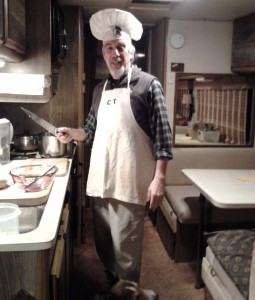 Remember, C.T. is cofounder of Food Not Bombs (note his spiffy FNB chef’s hat). He was a professional chef for years, and wrote the FNB cookbook. Serenity, with its propane stove and storage for bulk supplies, is his rolling playground. Lucky me!
Remember, C.T. is cofounder of Food Not Bombs (note his spiffy FNB chef’s hat). He was a professional chef for years, and wrote the FNB cookbook. Serenity, with its propane stove and storage for bulk supplies, is his rolling playground. Lucky me!
No, he doesn’t wear the hat every time he cooks! We’ve been having fun moving our belongings in, and it was the hat’s moving day…
I’d been reading that motorhomes have very limited power, compared to a house. So I wasn’t surprised to find out that we need to learn what to turn off before turning something else on.
Since Serenity will be the mobile office for three consensus trainers, we’ll have extra power challenges. How do we power several computers at once? The answer will
eventually be solar panels added to the roof. More on that another day.
For the moment, my computer is still in my old cabin, so now I must sign off and climb down into the valley to Serenity. I guess I’m commuting!
What’s on the list for tomorrow? Phone calls, emails, fundraising and troubleshooting.
Please join our Hippie Chick Diaries fan page on Facebook!
Occupy Asks the Classic Consensus Questions
C.T. and I get hundreds of emails each day, many of them from Occupy activists asking the same cluster of questions about consensus. They love their General Assemblies, as I love Intentional Community, and they can’t see abandoning their GA’s, so they’re desperate to make them work. Their hearts are searching for a way to bring the often shouting voices together. We have decided to share one such email, from OWS activist and workshop student Sati, with his permission. Sati’s words are in italics; C.T.’s answers are in regular font. —Wren
On Feb 9, 2012, at 11:45 AM, Satinath Choudhary wrote:
Dear CT,
I got your book – Consensus for Cities. Thank you very much.
You know CT, in as much as I would love to do things with consensus; my faith in consensus appears to be eroding.
C.T.: I understand your concern. Please keep an open mind towards the consensus process. I suspect the versions of consensus you have seen, especially @ OWS, were created by and practiced by people who had little to no prior experience with any consensus process. They nobly created a process from scratch without much help. It took me years to figure out what I know now and I was learning from people who had years of experience before I came onto the scene. And I was a meeting junkie. I literally went to over 1,000 meetings in one year (avg. 3/day)! Few are willing to invest that kind of time to learn something new. But I was willing and I invested the time. The result, the model of consensus I originally called Formal Consensus, then took me additional years to understand fully and to learn how to teach it to others. In fact, after 25 years, I am still learning about this model and how it operates in group dynamics.
Sati: What do you do when you suspect there are plants in a group that would like the group not to reach consensus – it would like the group to fail to make any decisions?
C.T.: This was my experience back in 1985 when I set out to develop a model of consensus that could not be disrupted by agent provocateurs. In the Quaker-based model of consensus I learned as a young activist between 1980-85, the approach to 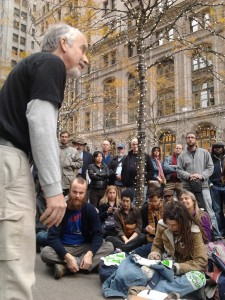 “blocking” was that any one individual could raise a block and, if the group could not satisfy the concern the block was based on, the proposal was defeated. I recognized that while this might be practical in a faith-based community such as the Religious Society of Friends (Quakers), this as unworkable in radical political groups where we know the State sends disruptors.
“blocking” was that any one individual could raise a block and, if the group could not satisfy the concern the block was based on, the proposal was defeated. I recognized that while this might be practical in a faith-based community such as the Religious Society of Friends (Quakers), this as unworkable in radical political groups where we know the State sends disruptors.
To address this problem generally, I recognize and now teach that requiring new people to go through a process of becoming a member of the group was essential. [Consensus for Cities, 1.1 New Member Orientation pp. 88-89 & 1.10 Membership pp. 97-98.] To address this problem more specifically, I developed the concept that “blocks” must be based on the purpose and common values of the group or contradict an existing decision. [On Conflict and Consensus (Third Ed.) 2.3 The Rules of Formal Consensus – Rule #5 pp. 27.]
Sati: What do you do when a group of people who are just too emotional, they start shouting at each other?
C.T.: The problem is NOT that people are too emotional. Just the opposite; people are emotional. Most groups subscribe to the notion that emotions have no place in group decisionmaking. This comes from the practice of using Robert’s Rules of Order. In this process (commonly referred to as “voting”) there is no place in the structure that allows for the expression of emotions. In consensus, the process does allow for the expression of emotion. However, since most people have experiences of using voting where emotions are “out-of-order”, they have learned to express emotions in inappropriate ways (such as shouting).
Additionally, with forms of consensus where there is little structure, an individual has no way of knowing when or how emotions can be appropriately expressed. In a 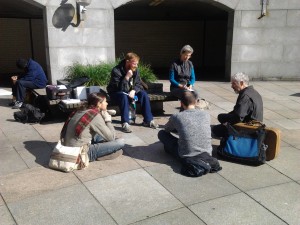 formal consensus process, the structure allows for emotional expression during a time when the group dynamics can easily support the individual and NOT at a time when emotional expression are disruptive or difficult to hear.
formal consensus process, the structure allows for emotional expression during a time when the group dynamics can easily support the individual and NOT at a time when emotional expression are disruptive or difficult to hear.
Sati: Consensus appears to fail even in a small group of people, how can we expect it to work in a large group of people like cities?
C.T.: Almost everyone asks me this question and it is precisely why I titled the second consensus book Consensus for Cities. People think consensus process only works in small groups of like-minded, trusting people. If I thought this were true, I would have given up on consensus long ago. Voting is based on power; it is the process of amassing enough power so that your proposal will prevail by gaining majority support. The consensus process that we teach is based on values; it is the process of identifying, articulating and using the common values of the group to determine if a proposal matches the group’s commonly held values or not. If it does, it is adopted, even if only one member wants the proposal; if it does not, it is defeated, even if everyone wants the proposal (unless the group changes their common values to match the proposal). How to do this process is what we teach in the 2-day workshop.
Sati: They can’t even gather together in one place. It seems to me that representative governance just cannot be avoided. Once the group of representatives is down to around 10 or so, we could possibly think of consensus.  But even in that situation, the interest of the super-rich is diagonally opposite to that of poor. How are they going to reconcile with each other?
But even in that situation, the interest of the super-rich is diagonally opposite to that of poor. How are they going to reconcile with each other?
C.T.: Contrary to popular opinion, the model of governance called representative democracy is NOT democratic. The structure of electing representatives who then make the actual decision for the larger group is called an oligarchy. Democracy is participatory or direct. Once you remove the decision making from “the people” or all the members of the group, it is no longer democracy. Consensus is all about direct, participatory democracy.
The interests of the super-rich are based on values, such as hierarchy, individualism, and competition. The values of OWS are egalitarian, collectivism and cooperation. These are two very different groups of people with different sets of common values that are mutual exclusive. The answer to your question is that they are not going to reconcile anything, especially using consensus process.
Sati: You must know that top governing body of Swiss is federal Executive Council (EC) of seven, elected every four years. They have been ruling the country since 1848 using consensus as their mode of working. Even they have abandoned to use consensus in the last four years after their right wing leader Blocher of People’s Party won support of 30% of country’s vote – more than any other party’s.
C.T.: You have exposed my most difficult problem regarding the version of consensus that I teach. Most everyone, including most dictionaries, see consensus as a form of voting, usually by super-majority or even complete, unanimous agreement. This is the kind of consensus the Swiss Executive Council uses (sometimes referred to as consensus-seeking with a majority vote over-ride).
I believe and teach that consensus process is a completely separate process, not based on voting at all. This is a radical perspective and not yet recognized by the over-culture (although, on the Wikipedia page on consensus, it is given a very brief nod by mentioning the Quaker model). It appears all the other models of consensus mentioned rely on voting in some form or other and much of the entry is devoted to various techniques of voting, such as hand signals, unanimity, etc.
I find this all very ironic since, as far as my research into consensus historically goes, in Western culture, all versions of consensus are based on the Quaker version and the Quakers learned it from the Iroquois Confederacy. Interestingly enough, this is mostly denied in the Wikipedia article, primarily based on the racist notion that “savages” could not have developed such a sophisticated process. It is also interesting to note that nowhere on this page is any reference to the Quaker involvement with the Iroquois or the influence of the Quakers on the founding fathers. (I have much more on this I will save for another time.)
Sati: I am yet to have a look into your book. I would like to read both of your books before I come to your workshop on Long Island.
Best regards,
Satinath
Sati will be attending our Consensus: Body and Soul workshop in Manorville, Long Island, February 24-26, 2012. Registration is still open. This will be our last East Coast workshop before we head west for a while. So take advantage of this chance! Contact us at fiopa@consensus.net for a brochure/registration form. —Wren
Post Script: 3/4/12: Sati and several members of OWS’ Vision & Goals working group, as well as Occupy activists from Boston and Philadelphia, participated in the Manorville workshop. Now Sati and other attendees are helping to recruit for another Consensus: Body and Soul workshop, to be held at the WBAI studios at 120 Wall Street, March 10-11. For more information on this new workshop, visit our facebook event page and call Wren at 410-458-2310.
Please join our Hippie Chick Diaries fan page on Facebook!
Boondockers: A New Social Class
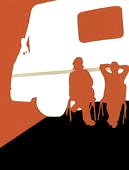 Some readers might be noting that Hippie Chick Diaries has changed dramatically. “Wren Tuatha’s Complicated Adventures in Simple Living” used to chronicle life in Intentional Community. Then it became the Occupy Diaries. Now brace yourself to follow me into a new form of simple living, boondocking!—WT
Some readers might be noting that Hippie Chick Diaries has changed dramatically. “Wren Tuatha’s Complicated Adventures in Simple Living” used to chronicle life in Intentional Community. Then it became the Occupy Diaries. Now brace yourself to follow me into a new form of simple living, boondocking!—WT
I am a rooted person. I come from farmers who owned the same lands from the Land Grant times to the present day. I thought that, if I wanted to, I could stay in my little homestead at Heathcote Community for the rest of my life. So I rooted and dug deep.
My partner C.T. is a gypsy. If I’m the farmer meme, he’s the nomad. He’s happy in a suburban lifestyle or couchsurfing. He follows the buffalo, or messages on the wind.
So, facing homelessness, we made a creative compromise: we’ll be nomads in a rolling house.
My home for the past sixteen plus years has been Heathcote, my community, my family, my agrarian tribe. We live on 110 wooded acres north of Baltimore, Maryland. For my first five years, I lived in a little springhouse on the stream, with my dog upstairs with me and ducks and a goat down below and grazing around.
 When my dog got too old to navigate that tiny house, I moved my little family up to a larger cabin on the top of the hill. Here, at Hina Hanta, we evolved as a family for ten years. I no longer keep ducks, and dogs and goats and come and gone. So have human partners.
When my dog got too old to navigate that tiny house, I moved my little family up to a larger cabin on the top of the hill. Here, at Hina Hanta, we evolved as a family for ten years. I no longer keep ducks, and dogs and goats and come and gone. So have human partners.
 Now, as Heathcote Community moves into a new phase that doesn’t include occupying these old shacks, my partner C.T., our dog Tuatha and I are leaving this forever home on Tuesday.
Now, as Heathcote Community moves into a new phase that doesn’t include occupying these old shacks, my partner C.T., our dog Tuatha and I are leaving this forever home on Tuesday.
We were touring Occupy sites when we got the news that we would lose our home. Ironically, as Occupy groups shifted from their tent city encampments to indoor meetings and direct actions protesting foreclosure evictions, C.T. and I were deciding not to fight the eviction we faced.
 Traveling by car, plane and train to various Occupys, we met many homeless people. Some had been homeless for years, often battling alcoholism and other issues. Others were newly homeless, with stories of Afghanistan or losing children.
Traveling by car, plane and train to various Occupys, we met many homeless people. Some had been homeless for years, often battling alcoholism and other issues. Others were newly homeless, with stories of Afghanistan or losing children.
Many were falling directly out of the middle class. And many middle class protesters were experiencing widespread joblessness as a new normal. Others were twisting their schedules to fit in activism with two and three menial jobs.
Knowing that I didn’t want to be truly homeless with a dog and a partner (shelters allow neither, apparently), I struggled to pool my remaining resources with whatever creativity I had to make a motorhome happen. Even in homelessness, privilege operates, and I have doors open to me.
 C.T. and I were already looking for an RV or tour bus to continue our Direct Democracy Tour of Occupy sites. We had planned to travel constantly with several other trainers, providing workshops and consultation. Our original idea had us raising $20,000 for a used bus or RV. As we learned the limits of our timeframe and our fundraising savvy, we settled on a thirty-four foot 1990 Fleetwood Bounder for $7000. The seller was excited to support our project and gave us a month to find the funds.
C.T. and I were already looking for an RV or tour bus to continue our Direct Democracy Tour of Occupy sites. We had planned to travel constantly with several other trainers, providing workshops and consultation. Our original idea had us raising $20,000 for a used bus or RV. As we learned the limits of our timeframe and our fundraising savvy, we settled on a thirty-four foot 1990 Fleetwood Bounder for $7000. The seller was excited to support our project and gave us a month to find the funds.
It breaks my heart to tell you how close we came to raising that money, gluing donations and loans and wishful thinking together. By my research, this was the least we could spend in the dependable range, imagining a rig that could get us from Maryland to California and back several times.
Then, facing living in someone’s basement, I lowered my definition of “dependable” to mean anything with four walls and a roof that could be mine, drivability optional.
Looking in the $2000-$4000 range, every RV on craigslist needed some repairs, and usually had been parked for years, never good news. We started looking at smaller RV’s, but they didn’t include the queen sized bed we wanted. Privilege again, because the dog must continue to be in the bed with us.!
 This lead us to a 1986 Sportscoach Cross Country, thirty-six feet! The listing sounded like the universe was finally rescuing us—complete repair records—evidence of the thorough/anal seller we love to buy from. New tires, breaks and break lines. A few cosmetic repairs needed.
This lead us to a 1986 Sportscoach Cross Country, thirty-six feet! The listing sounded like the universe was finally rescuing us—complete repair records—evidence of the thorough/anal seller we love to buy from. New tires, breaks and break lines. A few cosmetic repairs needed.
C.T. and I drove nearly four hours away and found ourselves four-wheeling our Honda CRV into a field, marveling at how very long this machine was. We were greeted by Chuck, a chain-smoking, swearing electrician and his Amish wife, Sally. “I have stuff stored in here,” he warned us. We stepped over the hole in the stairwell, where he had dismantled things.
We pulled ourselves up into what I can only describe as the lair where Chuck apparently goes to hide when he’s transformed by the full moon into a chain-smoking ware-gerbil.
Most horizontal surfaces nested piles of cigarette butts, no ashtrays noted. Machine parts nested in every plush chair, bench and couch. Boxes covered the queen sized bed. And little rips of paper swirled and netted in the carpet. Everywhere.
The toilet was oozing. It’s possible Chuck and Sally don’t realize the blackwater holding tank is not self-emptying or a portal to another dimension. To be fair, we do live in an out-of-sight, out-of-mind culture.
Okay, so it turns out that Chuck bought this motorhome from the anal type of seller we like. He’d had it for eight months, living in it while he finished their mobile home. There was a sad story about losing custody of their seven month old child because they were living in an RV.
That’s a story with more to it that what’s told.
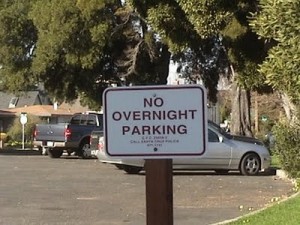 But it brings up to me the fact that there are so many millions—yes, millions—of Americans living full time in RV’s that municipalities are starting to take sides. Some are passing ordinances against parking overnight. In those towns, RVers often get harassed for just parking while they eat in a restaurant—at lunchtime. Other communities, and some of the big box stores, do the math differently. They see these travelers as bringing money into the local economy.
But it brings up to me the fact that there are so many millions—yes, millions—of Americans living full time in RV’s that municipalities are starting to take sides. Some are passing ordinances against parking overnight. In those towns, RVers often get harassed for just parking while they eat in a restaurant—at lunchtime. Other communities, and some of the big box stores, do the math differently. They see these travelers as bringing money into the local economy.
There are now websites listing parking lots where RV’s can park overnight in any given town. These are grocery stores, Home Depots, Lowes, Targets, and yes, WalMart stores.
Looking into RV living, the first lesson was that campgrounds are expensive, $35-$55 per night, and more. Although some have weekly, monthly and yearly rates, if you’re on the go, you can’t do that every night. So my second lesson involved a new vocabulary word: Boondocking.
Of course, as a native of the woods, the geographic concept of boondocks was not new. But I’ve learned that RVers have embraced this idea to refer to dry camping, with no water, electric or sewage hookups. Depending on your level of purity, the term refers to all dry camping, in parking lots to wild areas, or the term must be reserved to the most remote, untamed zones.
Apparently, there are millions of Americans traveling the parking lots, city parks, byways and mountain passes of the land. This may seem eco-unfriendly at first, but my third lesson has been that, for philosophical reasons or pragmatism, boondockers live on a tiny fraction of resources that other Americans do. They limit water use, and then reuse and re-reuse water (flushing toilets with dishwater) and they collect rainwater to use.
Boondockers quickly learn that it’s best to invest the $3000 in a few solar panels, then they’re not rotating their batteries and generator, and not needing to refuel that generator. They can stay independent longer. This becomes a goal that brings boondockers, whatever their politics, to greener and greener simple living.
There’s a real frontier attitude, very independent and individualist. Some boondockers might object to my characterization, pointing out all the website support groups and clubs. But, as C.T. points out in our workshops, there’s the value of cooperation and then there’s the strategy of cooperation.
C.T. tells the classic story of the college football team winning the championship. The reporters ask the coach, “What’s the secret of your team’s success?” He of course answers, teamwork, or cooperation. Very odd, since football is the epitome of violence and competition. The players aren’t concerned about the other team as they plant their faces in the mud. C.T. makes the distinction that they’re using the strategy of cooperation to achieve the goal of winning, of competition.
In that vein, I’m saying boondockers of all stripes are dropping out of mainstream society and forming a new nomadic social class. As people with my limited financial resources and nearly unlimited creativity realize that we’re not going to find real jobs, we fall out and land here. And, like other strata of society, individualism and 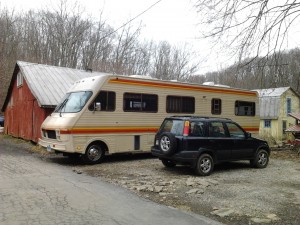 DIY rule. “I gotta get out of Babylon,” one hippie woman posted on a boondocker site.
DIY rule. “I gotta get out of Babylon,” one hippie woman posted on a boondocker site.
Indeed. We are the end of empire. Tear it down. And when there’s no more gas, we’ll each have four walls and a roof and a sense of mine and home.
Post Script: After letting the ‘90 Bounder go (just too expensive) and passing on Chuck and Sally’s rv (just too sad), C.T. and I found a cherry ride in a 31 foot 1986 Bounder, found in Middle River, Maryland. Now we’re boondocking at Heathcote while we work out some bugs in this rv’s systems. We’ve named her Serenity, after the Firefly series.
The adventures of a new Serenity crew begin!
—WT
Please join our Hippie Chick Diaries fan page on Facebook!
Wicca Sparrow January 21, 2004-February 11, 2012
February 11, 2012: Exactly one month ago today , a goat died. The call came that Wicca had passed in a freak accident. I wrote the obituary below for him. Then, in a later call, it was clarified that they’d been wrong. My two goats look nearly identical, but it was the darker, Niabi who had died. We grieved for two beloved pets in one day.
I didn’t have the will to write a second obituary.
This morning, the call came that the other goat passed from an infection. One month to the date. We are in shock. We are goatless and the world is now less two perfect, gentle souls. I now post Wicca’s obituary, which was acidentally made public briefly, but I had intended to keep private. Now I’m quite at a loss.—WT
from 1/11/12:
My step-sister had to make one of those calls this morning. Worse news can’t be imagined. One of our two goats we’d left in her care died yesterday.
A sweet, loving soul is gone from our lives.
This is the latest in a string of dramatic losses C.T. and I have incurred as we commit ourselves to touring Occupys and teaching consensus.
First, while we were on the West Coast, our community consensed to abandon the house we live in due to zoning regulations, rather than go through a lengthy and possibly expensive process to fight for the right to continue occupying ours and several other homes, which have been part of the community since 1965.
 We didn’t fight that. We accepted the decision, giving up the home I’ve had with my pets and partners for fifteen years.
We didn’t fight that. We accepted the decision, giving up the home I’ve had with my pets and partners for fifteen years.
Having no home to go to, we made the heart-wrenching decision to send our goats several states away to be fostered on a farm for the next year, while we tour and seek a new community.
Less than a month into that separation, Wicca is dead. It was a freak accident, that many will say could have happened anywhere.
We feel so badly for his companion goat, Niabi, and for Beth and Sandy, the step-family who stepped up to house them when other friends and family did not.
 Today I remember Wicca and our special relationship. C.T. and I walked the woods today, tracing the early morning path Wicca and Niabi used to take to do their browsing. We looked at the house we’re about to lose from their perspective and remembered how they used to come running on their little stubby legs whenever we humans would emerge from the cabin.
Today I remember Wicca and our special relationship. C.T. and I walked the woods today, tracing the early morning path Wicca and Niabi used to take to do their browsing. We looked at the house we’re about to lose from their perspective and remembered how they used to come running on their little stubby legs whenever we humans would emerge from the cabin.
We remembered Niabi and Wicca rearing up on hind legs to butt heads, a “high five” in goat culture. Niabi has no goat companions now to join him in high fives.
 I recalled the day I brought Wicca home. I had a solitary goat, Willow. And finally I’d gotten him a companion. They don’t do well alone. I took the kid first to show other Heathcoters. He was eight weeks old, my first baby goat in a dozen years.
I recalled the day I brought Wicca home. I had a solitary goat, Willow. And finally I’d gotten him a companion. They don’t do well alone. I took the kid first to show other Heathcoters. He was eight weeks old, my first baby goat in a dozen years.
I opened my arms and let him down on the ground, not appreciating that he’d just been stolen from his mother and had no bonding with me. He darted off and a bunch of us chased him all around the woods. He jumped into the stream, a jarring experience, I’m sure, because goats hate water. That’s where we were eventually able to catch him.
 After drying him well, because goats are prone to pneumonia, I walked him up the hill. Willow at the top heard us and called out. Wicca answered and they did call and response about twenty times before they were within sight of each other.
After drying him well, because goats are prone to pneumonia, I walked him up the hill. Willow at the top heard us and called out. Wicca answered and they did call and response about twenty times before they were within sight of each other.
Willow was a loving, nurturing mentor to the baby goat. But when Willow died that winter, Wicca was less than a year old.
Wicca was lost without a companion and began to show symptoms of failure to thrive. I brought him into the house to be with me and the dog. And I set about finding a companion.
Each night, when Tuatha the dog and I would go upstairs to bed, Wicca would cry out in his crate. Tuatha would turn around and go to him. He laid next to the baby goat every night until we brought home baby Niabi.
I had appreciated that my goats had tended to pass down culture from the older to the younger. The older would teach the new arrival what in the woods was food and what was not. Tabitha had taught Atthis and Willow; Willow had started to teach Wicca. And there was a clear leader/follower hierarchy. I nicknamed Willow and Wicca Skipper and Gilligan.
 I wanted to get a goat that tiny Wicca could boss, so he wouldn’t be dominated all his life. After an exhaustive email campaign, Wicca, Tuatha and I traveled to New Jersey to adopt Niabi.
I wanted to get a goat that tiny Wicca could boss, so he wouldn’t be dominated all his life. After an exhaustive email campaign, Wicca, Tuatha and I traveled to New Jersey to adopt Niabi.
Niabi was growing smaller than expected so he wouldn’t be used as a breeding buck. The breeders had nicknamed him “the dark one” after his very desirable coloring, and he was dripping in the privilege of one who expected to be king, even then.
Wicca, being older, did get in a few months of butting and hazing and dominating, mixed in with bonding and being inseparable. But somehow, even though he always remained smaller, Niabi became king.
Until recently, they lived a life of rare freedom for goats. They were completely free range in the expansive woods of Heathcote, browsing a several acre radius around our cabin. They had a cute little cob goat house, but preferred to sleep under our house, to be closer to us. Their favorite game was the ongoing contest to sneak onto the porch. They studied our movements for any opportunity to find us gate open, attention elsewhere, so they could tramp onto the porch landing and score points. More points if they could find the house door open and get a few bites of Tuatha’s vegan dog food! Niabi, always ambitious, outscored Wicca by a huge margin.
 But Wicca would rather be polite than win. He was content to shrug off the hierarchy of goats and just be Mama’s teddy bear. While Niabi likes to pretend he hates attention and petting, except from his special pal C.T., Wicca was a hugga muffin, always ready to snuggle or have me drum on his belly.
But Wicca would rather be polite than win. He was content to shrug off the hierarchy of goats and just be Mama’s teddy bear. While Niabi likes to pretend he hates attention and petting, except from his special pal C.T., Wicca was a hugga muffin, always ready to snuggle or have me drum on his belly.
In their free range world, we almost never fed them, as they got what they needed from the woods. They were bonded closely to us by choice. I’m sad that Wicca’s life has ended while we were parted. And I thank this gentle being for being part of my life.
Signed,
Mama
Please join our Hippie Chick Diaries fan page on Facebook!
Back Office in Bloomfield
We’re on our second day of visiting my hometown Occupy, Louisville! We’ll combine it with visits to the Occupy in Lexington, the city of my birth. But our mornings of back office work are rural, at my family’s farm near Bloomfield, Kentucky. As I work away on emails and follow up phone calls, trying to finalize workshop times and set up fundraiser house parties, I’m stuck in the front parlor of this old farmhouse. I wouldn’t choose any other activity in this moment, but those rolling hills do call through the window screen.
Our dog Tuatha is bored silly, with my nephew in school and no one interested in frequent ball games. My sister-in-law tried to take him for a walk on the farm, but he’s back in the house, so it didn’t take. Not without Mama!
C.T. is also busy following up with potential funders and a publisher who is considering distributing C.T.’s consensus books to a national base. We have sold more books in the last month and a half than in the last three years.
If you pick up on the main stream media’s message that Occupy is history, think again. Demand for our work says otherwise.
In fact, the bias of corporate-owned media continues with today’s coverage of the Occupy shut down of ports, depicting the action as harming the port workers, who are part of the 99%. No real attempt to counterweigh that with Occupy’s motivations was made in the CNN article I read.
Our work continues. We ran out of Consensus for Cities, C.T.’s book on how to do consensus in groups of 100,000 or more. So we had more printed and shipped to us on the road. Now we’re restocked and debuted the new copies on the square in Louisville last night.
Louisville’s General Assembly was quite civil, compared to many where we’ve seen novice facilitators struggle with how to manage disruptors shouting. This group seems to have moved unruly people out of their encampment. Even so, they’ve had to deal with theft, drugs and other issues that happen when you arrive in a public space and set up free food, blankets and tents! Occupy groups are learning to clarify their concepts of membership. The experiment continues!
Recircle Your Wagons: Buy Ins and Outcomes along the Occupy Highway
Now well into our second month of our official tour, C.T. and I are starting to revisit some Occupy sites and deepen our relationships with protesters as they try new meeting skills.
One of the paradigm shifts we are teaching is to avoid being outcome oriented. Consensus really blossoms when we’re not attached to a particular solution, but instead curious what ideas the discussion will bring.
So I have to laugh at myself when I look at our teaching in terms of outcomes—Are we making a difference? Are facilitators and other activists learning real tools they can and do use? Are these tools helping all voices to be heard?
In short, yes. We can see differences in working group meetings, GA’s, and even online discussions. Folks in Chico were able to structure their GA better and handle disruptors. They went from one person planning the agenda five minutes in advance to a team having a real agenda planning meeting. Some Occupy Chico members who hadn’t attended our Consensus: Body & Soul workshop accused us of being some kind of cult, but workshop participants were articulate about how consensus really is about all voices being heard.
Occupy folks who attend our talks or meet with us at length get these very intense looks on their faces as the gravity of the paradigm shifts lands on them. They take in the bombshells that C.T. volleys at them:
- A group is by definition not everybody. Inclusion is not about letting everybody in, no matter what drugs they’re on or how they behave. Rather inclusion is creating a safe container by enforcing expectations of behavior and making space for everyone willing to participate in making that safe container. No rulers, not no rules.
- It’s actually easier to change the behavior of the entire group toward a disruptor than change the behavior of the disruptor. Recircle your wagons! If a person won’t stop shouting, have everyone turn away. Even if the facilitators have to end the meeting, you’ve done a better job of creating safe space for the future than if you let someone disrupt.
- “If war is the violent resolution of conflict, then peace is not the absence of conflict, but rather the ability to resolve conflict without violence.” —C.T. Lawrence Butler, On Conflict and Consensus
- When you have competitive and cooperative people in the same group, the competitive people always win. There are two reasons: 1) The competitive people are trying to win, and 2) The cooperative people are trying to help them! Duh!
The list goes on, lesson after lesson, laid down at encampment after encampment. It’s not exactly a look of shock that repeats across the faces. It’s more the weight, the opening of the mind, the realization that the original OWS template created many of these problems. And turning it around seems impossible. But it’s not.
Recircle Your Wagons!
Organic change can happen in the Occupy movement without trying to sell a GA hijacked by angry disruptors on the idea of a better structured direct democracy.
 If you’d like to see a movement with a clarified, mature understanding of inclusion, a movement based on true consensus (not voting in disguise), a movement that is making the paradigm shifts that go along with cooperation, then start with an affinity group.
If you’d like to see a movement with a clarified, mature understanding of inclusion, a movement based on true consensus (not voting in disguise), a movement that is making the paradigm shifts that go along with cooperation, then start with an affinity group.
Form an affinity group around these ideas. The membership is not open to whoever finds out about the meeting place and shows up, the membership is defined by common values and interests. Your group could be the  food working group or a group just established to study consensus together. It doesn’t matter. You’re not working outside of the Occupy structure. You’re not splitting off. You’re an affinity group. You don’t need permission to exist. If this group succeeds in getting work done without the drama people see in GA’s, word will spread. Best practices will spread. Let it go viral.
food working group or a group just established to study consensus together. It doesn’t matter. You’re not working outside of the Occupy structure. You’re not splitting off. You’re an affinity group. You don’t need permission to exist. If this group succeeds in getting work done without the drama people see in GA’s, word will spread. Best practices will spread. Let it go viral.


